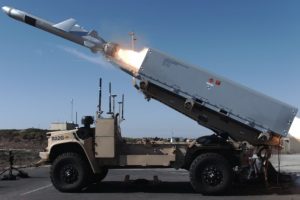A top Marine Corps officer recently said the service’s next budget will focus on logistics, transferring data securely, and organic mobility while also illustrating the service has had the most progress on force design changes in long-range precision fires.
The fiscal year 2024 budget request will highlight logistics and transport layers, Gen. Eric Smith, Assistant Commandant of the Marine Corps, said during the Defense News Conference on Sept. 7.

“Those are two of the things that I would leave you with. How do I transport that data securely? You’re gonna see that, you’re gonna see a focus on organic mobility…and you’re going to see logistics. How do I sustain that force? Those are three areas that you’re going to see in ‘24.”
Smith also said the service has made the most progress in long-range precision fires as it focuses on Force Design 2030.
“We demonstrated the Naval Strike Missile a couple years ago, we’ve demonstrated organic precision fires, infantry and mounted.”
He noted the Marine Corps has tested the use of the Tomahawk anti-ship missile off of a Joint Light Tactical Vehicle and is procuring the MQ-9A unmanned air vehicles as “the airborne quarterback” for surveillance and communications.
However, Smith reiterated that “the part that is the most challenging is the transport layer. We are working hard to make sure we have a secure transport layer.”
He said the Marine Corps has successfully been using the Northrop Grumman [NOC] AN/TPS-80 Ground/Air Task-Oriented Radar (G/ATOR) to coordinate the fires in demonstrations, which he called a “phenomenal success story,” and has tested Israel’s Tamir missile, used in the Iron Dome system.
Smith noted if the Marine Corps ultimately decides to procure the Tamir it would form the Corps’ medium-range intercept capability.
He also underscored that the Force Design changes are making China uncomfortable, which means they should do more of it.

“I think the things that we’re seeing is that every time we build a force, and produce elements of that force that have organic mobility, that have low signatures, that have lethality when you combine those things, the [People’s Republic of China] and other adversaries don’t like that. They don’t like it at all.”
“Because there’s a force that’s out there that’s organically mobile: KC-130s, CH-53Ks, MV-22s, light amphibious warships and traditional L-class ships. And it has long range fires, Naval Strike Missile, Tomahawk, and it has the ability to thicken the kill web, to sense and make sense using that MQ-9 drone for example. Those Marines that are out there reconnaissance…who can identify an adversary, who can catalog a target during peacetime and then use that data to track that target across the battlefield at all times, so that if war breaks out, we can immediately begin to hold that target at risk,” he continued.